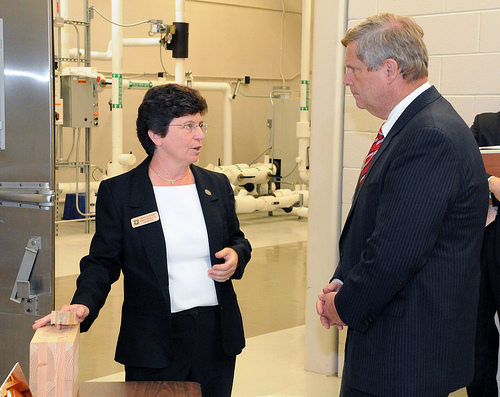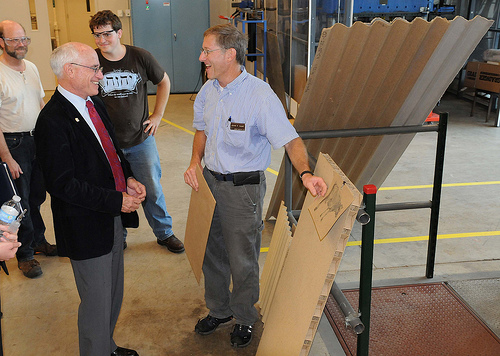
Forest Service research led to the creation of Hollywood’s first 100 percent sustainable studio set.
Hollywood’s first 100 percent sustainable studio set was created for 20th Century Fox’s comedy series “Raising Hope” thanks to the efforts of the U.S. Forest Service’s Forest Products Laboratory and NOBLE Environmental Technologies, a long-term collaborator with the laboratory.
NOBLE Environmental Technologies’ patented ECOR® panels, which were developed in partnership with laboratory researchers, were used to create a modern hotel suite for a two-part episode of the show. ECOR® is a recycled, lightweight panel product that is strong but weighs as little as one-fourth the weight of conventional wood product panels. The product is 100 percent, USDA-certified bio-based and made with 100 percent cellulose fibers including post-consumer paper, wood and agricultural raw material sources. ECOR® contains no toxic additives or adhesives. Read more »

Aldo Leopold seated on rimrock above the Rio Gavilan in northern Mexico while on a bow hunting trip in 1938. (Photo courtesy Aldo Leopold Foundation)
Over his 40-year career as a forester, scientist, teacher, and writer, Aldo Leopold brought a greater understanding of our relationship with the natural world at a time when the technological advances of the 20th century increasingly shut people off from their surroundings. Read more »

Research Microbiologist Carol Clausen discusses wood durability and protection research with Agriculture Secretary Tom Vilsack during his visit to the Forest Products Laboratory.
The Forest Products Laboratory (FPL) recently guided USDA Secretary Tom Vilsack through its unique set of research facilities. Basic and applied research at FPL supports a number of objectives, including forest management and restoration, the wise use of forest resources, job creation, and expanding economic opportunities through public-private partnerships on a national scale.
Throughout his tour, Secretary Vilsack talked with lab leadership about FPL’s diverse and innovative research efforts. Project leaders used the opportunity to field questions from the Secretary and explain work ranging from wood preservation and durability to advances in “green” building strategies and technology, use of beetle-killed trees, work on historic timber bridges, and advances in nanocellulose-related materials and applications. Read more »

The ladder used to convict Bruno Hauptmann of kidnapping is seen here in a contemporary crime-scene photograph. Scientists at the Forest Products Laboratory were able to prove that one of the steps used in the ladder was from a plank of wood in Hauptmann’s attic. Forest Service photo.
In the early 1930’s, before the age of DNA and forensics, piecing together the evidence of a crime scene was a difficult task involving fingerprints (if you could get them), eyewitness accounts (if there were any), or a confession (not likely). Law enforcement had none of these as they tried to convict Bruno Hauptmann, the man they believed was guilty of what was then being called the “crime of the century”– the kidnapping and murder of the Lindbergh baby.
It was amid this national media frenzy that the U.S. Forest Service Forest Products Lab would in many ways introduce the concept of forensics into crime solving. Read more »

USDA Under Secretary Harris Sherman (front left) meets with FPL researcher John Hunt (front right) as representatives from FPL partner Noble Environmental Technologies look on (in background, Jim Jensen and Caleb Walker).
A recent visit to the US Forest Service Forest Products Laboratory by USDA Under Secretary Harris Sherman was an eventful one. Sherman took the opportunity to visit with industry leaders who have collaborated with federal scientists to bring innovative new products to the market. Sherman was at the laboratory on July 25 for a grand opening of the new Nanocellulose Pilot Plant along with scores of industry leaders, scientists and academic researchers. Read more »
The U.S. Forest Service Forest Products Laboratory recently opened a $1.7 million production facility for renewable, forest-based nanomaterials. This facility is the first of its kind in the United States and one that positions the laboratory as the country’s leading producer of these materials, also called nanocellulose.
Nanocellulose is simply wood fiber broken down to the nanoscale. For perspective, a nanometer is roughly one-millionth the thickness of an American dime. Materials at this minute scale have unique properties; nanocellulose-based materials can be stronger than Kevlar fiber and provide high strength properties with low weight. These attributes have attracted the interest of the Department of Defense for use in lightweight armor and ballistic glass. Companies in the automotive, aerospace, electronics, consumer products, and medical device industries also see massive potential for these innovative materials. Read more »





